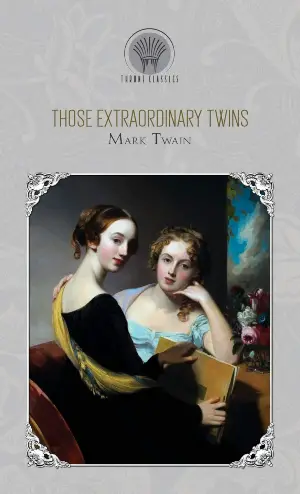Discover the wit and wisdom of Mark Twain with our free collection of Mark Twain books in PDF format.
Mark Twain, often called the “father of American literature,” captured the humor, challenges, and heart of 19th-century America. His works remain as engaging and relevant today as when they were first written.
From the adventurous The Adventures of Tom Sawyer and Adventures of Huckleberry Finn to his sharp essays and lesser-known gems, Mark Twain’s writing combines humor, social critique, and unforgettable storytelling.
Perfect for readers of all ages, this collection invites you to explore the works of a literary icon whose timeless tales continue to inspire and entertain.
Download these Mark Twain books in PDF now and immerse yourself in the classic stories that have shaped American literature.
1) The Innocents Abroad

In 1867, the first modern tourist excursion of the time departed from the port of New York, bound for the most classic sites of the Mediterranean. Twain embarked on this excursion, armed with his sharp humor and his distinctive command of language, with the idea of sending chronicles of his trip to the newspaper that sponsored his trip, the Alta California.
In The Innocents Abroad, Twain talks about himself, the old masters, Michelangelo, the Neapolitan or French tour guides, and the Pilgrims and their journey to the Holy Land.
Two years later the book was edited with Mark’s notes, which achieved great success since it was used by Americans as a travel guide.
2) The Gilded Age: A Tale of Today

It is the only novel Twain wrote in collaboration with another writer, his good friend Charles Dudley Warner, who was also an editor. It is known that Mark wrote the first 11 chapters, followed by 12 chapters written by Charles. The next were written by only one of them, and the last few are attributed to joint authorship.
The Gilded Age was completed between February and April 1873 and was first published that same year. At that time its title became synonymous with materialism, greed and corruption.
The story is set in Washington, D.C., and satirizes the corruption of the ruling class, whose plot revolves around their desire to enrich themselves through speculation, a theme that is still relevant in today’s society even though more than a century has passed since the work’s publication.
3) The Adventures of Tom Sawyer

In this work Twain relives his childhood and his adolescent days combining them with fiction. The story is a tale for children full of adventures where the little ones are the heroes, but the novel also includes a direct and clear message for adults.
The Adventures of Tom Sawyer spans a few months in the life of Tom, who lives on the banks of the Mississippi River and is raised by his Aunt Polly. Although his aunt loves him sincerely, she also subjects him to unpleasant and even absurd discipline.
Tom has a different perspective of the world from how adults see it, which is why his reactions to his elders are so amusing. His friend Huckleberry Finn is even more rebellious and wild than Tom, making him the ideal companion for him.
4) A Tramp Abroad

A Tramp Abroad is a work of travel literature published in 1880. In it Mark included facts lived and experienced by him, as well as fictional ones. The plot takes place in a journey of the author and one of his friends through southern and central Europe: part of Germany, the Alps and Italy.
The story is humorous, especially because of the situations experienced by the two men, their respective reactions to such events being even funnier. The first part describes their travels through southwestern Germany, specifically Heidelberg, Mannheim and Baden-Baden, among other places.
The second part of the book takes place in eastern France and Switzerland: Lucerne, Interlaken, Zermatt, Geneva, etc. And the last part covers their journey through several cities in northern Italy: Milan, Venice and Rome.
5) The Prince and the Pauper

This book, first published in the United States in 1882, is Mark Twain’s first attempt to develop a work of historical fiction. The story is set in 1547, and tells the story of two children who have two things in common: they were born on the same day and are identical in appearance.
But, at the same time, they differ in that one is a beggar and the other a prince. The pauper is Tom Canty, who lives with his abusive, alcoholic father in London, and the prince is Edward VI of England, son of Henry VIII of England.
Although The Prince and the Pauper was written for children, adults can also learn from the message it tries to leave us with: the consequences of social inequality and how unfair it is to judge others only by their appearance.
6) Life on the Mississippi

Life on the Mississippi is a non-fiction narrative writing based on his personal recollections (a memoir), so it is understood that the events that take place in the work happened in reality. It was published in 1883.
In this work he tells us with great affection anecdotes such as his training as a steamboat pilot as well as the science of navigating the ever-changing Mississippi River. Although Twain was 21 when he began his pilot training, he is presented in the story as somewhat younger, referring to himself as a “boy who ran away from home” to seek his fortune on the river.
In the second part, Mark narrates his journey, many years later, from St. Louis to St. Paul, where he makes two trips on a steamboat, and gives us his impressions of the great new cities he observes.
7) Adventures of Huckleberry Finn

Adventures of Huckleberry Finn is considered one of the best classics of American literature. This book represents the culmination of the narrative of the writer known worldwide as Mark Twain.
In this classic, the author shows off his agile prose, his sense of humor, his precise and shining writing, and transports the reader to the Mississippi River with the main character and unforgettable Huck Finn. Finn sets out in search of his freedom in the company of Jim, a colored boy who wishes to escape from slavery.
In this novel the author talks about friendship, happiness and adolescence. «Adventures of Huckleberry Finn» is a must-read book ideal for any age, and has been adapted for film and television on several occasions.
8) A Connecticut Yankee in King Arthur's Court

Being Mark Twain one of the authors who best represents the contradictions of his time, his enormous confidence in the technological projects of the second half of the 19th century, combined with his distrust and disillusionment that progress itself caused him, A Connecticut Yankee in King Arthur’s Court reflects all that dichotomy.
Twain begins his work by mocking and satirizing the past of the medieval era and ends by questioning the predominance of modern, industrialized modernity.
After suffering (in an unexplained and inexplicable way) a blow to the head, Mark -a Yankee- suddenly finds himself transported years back in time, taking with him everything he knows about the technological advances of the 19th century, as well as his Protestant and Republican ideology.
9) The American Claimant

The American Claimant is a novel from 1892. Its cast of characters includes: Colonel Mulberry Sellers who is an eccentric old man who becomes the rightful heir to the Earl of Rossmore. His daughter Sally who falls in love with Howard Tracy and gives up her aristocratic aspirations to be with him.
In addition to: Berkeley Rossmore (Howard Tracy): the only son and heir of the Earl of Rossmore, who announces his intention to go to America and “change places” with Simon Lathers, whom he considers the rightful heir.
In addition, Berkeley wishes to retire from what he considers a false position and thus begin his life anew without aid. After his arrival in the country, the hotel where he is staying burns down and the newspapers leave him for dead. Taking advantage of the situation, Berkeley renounces his former identity and calls himself Howard Tracy.
10) Those Extraordinary Twins

Curiously, when writing this story, Twain did not have a clear idea of it, something that the reader can perceive, but it could still be considered a classic of the humor genre.
Those Extraordinary Twins tells the story of “a man with two heads” -to be more precise, twins sharing one body- who visits a small town and stays in a rooming house where an aunt, her daughter and two little brothers live together. The story (always in a humorous tone) tells us how the brothers react with the townspeople and vice versa.
Also about how the two heads interact with each other, since the brothers are different individuals, with very different points of view on various topics such as: politics, religion, etc.
11) The 1,000,000 Bank Note and Other New Stories

It is a collection of nine humorous stories from 1893, we also find essays and literary criticism with reflections on society and culture and ideas about human nature, and travelogues that include the author’s recollections.
In The £1,000,000 Bank Note, the life of a man from San Francisco takes a surprising turn. He finds himself penniless in England, and for some reason his misfortune interests two wealthy eccentrics who decide to bet on him. This bet catapults the man to wealth, status and fame in London society.
The other stories included are: Mental Telegraphy; A Cure for the Blues; The Enemy Conquered, or, Love Triumphant; About all Kinds of Ships; Playing Courier; The German Chicago; A Petition to the Queen of England; and, A Majestic Literary Fossil.
12) Pudd'nhead Wilson

In a bland and small town located in Missouri, a slave woman would definitely change the future of the main family of the region.
Roxy, in charge of taking care of her masters’ son and her own son, decides to exchange the children in their crib, without foreseeing that this action, executed to avoid a life of slavery for her son, will be the reason for dramatic events years later. Events that include gun duels, robberies and a terrifying parricide crime.
This is a play that combines courtroom drama, comedy and investigation. Pudd’nhead Wilson is undoubtedly a strong plea against slavery and racial prejudice. It is considered one of the main works of the humorist and precursor Mark Twain.
13) Tom Sawyer Abroad

It is an amusing adventure novel published in 1894 that stars Twain’s most beloved characters: Tom Sawyer and Huck Finn, who are accompanied by the freed slave Jim.
In the story, they decide to escape civilization and venture on a trip to Africa in a futuristic hot air balloon to see some of the world’s greatest wonders, such as the Pyramids and the Sphinx. As in other Twain works, Huckleberry Finn acts as the narrator of the story, telling us about events such as: their encounters with robbers and lions, how they rescue a boy from bandits, his visit to landmarks, etc.
In addition, we also have more serious conversations between the three friends about topics such as religious tolerance, racial discrimination, society and its flaws, which make Tom Sawyer Abroad a must-read book.
14) Tom Sawyer, Detective

It is a novel from 1896 in which Twain satirizes the detective novels that were very fashionable at the time. In it Tom Sawyer tries to solve a mysterious murder being -of course- accompanied by his faithful friend Huckleberry Finn, who helps him acting as a Dr. Watson.
In Tom Sawyer, Detective, Tom and Huck will travel down the Mississippi on a steamboat where they will find themselves in the middle of a plot that includes the theft of diamonds and even a murder. The story – like many others by the author – is narrated in the first person by Huck Finn.
With an agile but easy-to-follow pace and a plot embellished with Twain’s usual sly humor, Tom is shown as a detective with a great capacity for deduction, who manages to give a happy ending to an adventure.
15) Personal Recollections of Joan of Arc

Twain’s Personal Recollections of Joan of Arc is a vigorous, realistic, dramatic, magnificent and evocative book.
This book transports the reader to the fullness of the Hundred Years’ War, in all its splendor. The story unfolds around the exalted, illustrious and brave figure of Joan of Arc, and a vigorous and splendid picture of the century, full of majesty and harmony.
Throughout these exciting pages occur one after another, scenes full of heroism linked to the loyal figure of Louis de Conte, squire and companion of Joan in her conquests on the battlefield, whom the narrative genius of Mark Twain makes the supposed author of this great story, which could be part of the most incredible legends of chivalry.
16) Extracts from Adam's Diary

Extracts from Adam’s Diary is a humorous and ironic tale, first published as a book in 1904, by Harper & Bros. This work is a parody of the book of Genesis, which is the first book of the Christian Old Testament, does not consider the role of God at all but focuses on Adam and Eve.
It begins with Adam describing how Eve is introduced into the Garden of Eden, and how he has to deal with her, whom he also describes as an annoying creature although he eventually ends up falling in love with her.
In addition, it also details the encounter with Cain, who at first strikes Adam as a perplexing creature without being able to identify the species to which he belongs, thinking he is a fish, then a kangaroo, then a bear. Finally, he discovers that it is a human, like himself.
17) What Is Man?

«The studies for these papers were begun twenty-five or twenty-seven years ago. I have examined them once or twice per year since, and found them satisfactory. I have just examined them again, and am still satisfied that they speak the truth. Every thought in them has been thought (and accepted as unassailable truth) by millions upon millions of men-and concealed, kept private. Why did they not speak out? Because they dreaded (and could not bear) the disapproval of the people around them. Why have not I published? The same reason has restrained me, I think. I can find no other». Mark Twain.
What is Man? is an enlightening and illuminating essay about the advances in genetics and genetic engineering, the possibilities of the scientific, moral and human realm of the latest line of science that presents a new world to mankind.
18) The $30,000 Bequest and Other Stories

The $30,000 Bequest and Other Stories of 1906, is a collection of thirty previously published short comic stories and essays. The stories span the course of Mark Twain’s career, from “Advice to Young Girls” to the story that gives the book its title.
Although Mark had ample time to modify and refine these works between the date of their original publication and this collection, indications suggest that he took little interest in doing so, as they contain only minor technical revisions that differentiate them from their earlier version.
Some of the works it contains are: The First Writing Machines, Italian with Grammar, How to Tell a Story, General Washington’s Negro Body-Servant, An Entertaining Article, A Letter to the Secretary of the Treasury, Amended Obituaries, A Monument to Adam, A Humane word from Satan, Advice to Little Girls, Post-Mortem Poetry.
19) Christian Science

This is a collection of essays that Mark Twain wrote about Christian Science, which is a set of beliefs and practices belonging to the metaphysical family of new religious movements.
The author’s first article on this subject was published in Cosmopolitan in 1899, a work of fiction in which he describes how he fell off a cliff and broke several bones. As a result, a Christian Science practitioner who lived nearby was sent for, but was unable to attend to him immediately but undertook to provide him with an “absent healing.”
In 1907 he published Christian Science, where he compiled that and other articles he had written on the subject. Due to a certain ambivalence of Twain some think that this work is a criticism with an ironic tone and not an essay where the author shows his support and interest towards this science.
20) A Horse's Tale

It is a 1906 short fiction novel originally published by Harper’s Magazine in two installments, one in August and the other in September. As was characteristic of Twain, it is marked by sharp humor and satire. It is a book that addresses the perspectives of life and our reasons for existing.
The story is approached mainly from the point of view of the protagonist, Soldier Boy, who is the favorite horse of the famous soldier Buffalo Bill, as well as from the perspective of Cathy, a 9-year-old orphan girl. It is believed that Mark based this character on his daughter Susy, who died in 1896 when she was only 24 years old.
Both characters become attached to each other and will end up starring in their own adventures. A Horse’s Tale is a beautiful story with exciting events that will be enjoyed by young and old alike.
21) Captain Stormfield's Visit to Heaven

Captain Stormfield’s Visit to Heaven is a short story that was published in book form (with some revisions) in 1909, after appearing in Harper’s Magazine in December 1907 and January 1908. It was also the last story published by Twain during his lifetime.
In the story, all sentient life forms travel to heaven, often through interplanetary or interstellar space. The work introduces us to Captain Elias Stormfield on his cosmic journey to Heaven and Sandy McWilliams, a cranberry farmer who has much experience in the ways of Heaven.
The Heaven McWilliams describes is similar to the conventional Christian Heaven. And as Stormfield progresses through it, he learns that whatever is desired is granted to its seeker, as long as it does not violate any prohibitions, and that these prohibitions are different from those on Earth.
22) The Mysterious Stranger

This work was published posthumously by Albert B. Paine, Mark Twain’s literary executor.
The Mysterious Stranger is a novel that develops the satirical and at the same time moral facet of the author. In this story a strange character arrives in a small Austrian village and this reveals the real character of human nature, and then leaves an unsettling sense of the unreal.







































